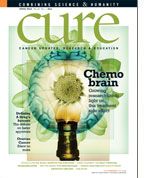Publication
Article
CURE
Mining Cancer Data in the Molecular Age
Author(s):
Modern medicine no longer relies on information just gleaned from under a microscope.
For more than a century cancer was defined largely by what a pathologist observed under a microscope. The “gross morphology”—the shape, the structure and the component parts of the cancer cells taken from a biopsy—provided the only real road map for treatment.
And it wasn’t so long ago that cancer researchers kept most of their records on paper, sharing their findings with fellow researchers by sending tissue samples through the mail and transmitting notes over facsimile machines. Even after the World Wide Web was up and running, clinicians relied heavily on medical journals, scientific meetings and other methods of dissemination of research to make critical decisions about how to help patients with advanced forms of the disease.
Modern medicine no longer relies on such outdated research protocols.
Assisted by in silico (via computer) research, gene mapping and detailed digital pathology, scientists can now peer well beyond the biopsies of patients and predict pathways inside cells that look harmless but may provide the triggering mechanism that unleashes cancer’s spread. This, in turn, can lead to targeted treatments against some of the most difficult and lethal forms of the disease.
The programming infrastructure that enables information and analytical resources to be shared efficiently and securely among cancer researchers is called caGrid. The open-source information network that caGrid supports is called caBIG (Cancer Biomedical Informatics Grid), a major initiative of the National Cancer Institute. These developments have propelled cancer research into the molecular age and hold great promise for future clinical care.
Scientists can now peer well beyond the biopsies of patients and predict pathways inside cells that look harmless but may provide the triggering mechnism that unleashes cancer's spread.
One of the first rounds of in silico research is concentrating on the genetic pathology and treatment outcomes of brain tumor patients obtained through the Cancer Genome Atlas and other sources residing on the caBIG.
By utilizing rich, molecular data sets, linking them to digitized pathologic slides and annotated neurological images—as well as detailed information about patient treatments and results—brain tumor research can be conducted on a much larger scale and at a much deeper level than ever, says Daniel Brat, MD, PhD, a professor of pathology and laboratory medicine at Emory University in Atlanta. (Similar work is going on at other centers studying lung and ovarian tumors—two other forms of cancer that have proven to be stubbornly resistant to conventional therapy in patients with advanced forms of the disease.)
Patients who agree to participate in the research allow tissue samples, radiographic images, clinical notes and other details of their diagnosis and treatment to be shared with the cooperating institutions, which in turn agree to protect their identities. Names and other information that would personally identify the patient do not become a part of the record.
Researchers at Emory and elsewhere learned in the space of a few months what would have otherwise taken years to find about a range of genetic mutations in some glioblastomas, the most common malignant brain tumors in adults.
Correlating this information may allow researchers to target specific therapies for specific tumor types to keep them from triggering the genetic “on/off” switch that spreads the cancer so rapidly and leads to death, Brat believes. Similarly, they may find that some forms of therapy cause a hypermutation of the gene and should therefore be avoided in some patients.






